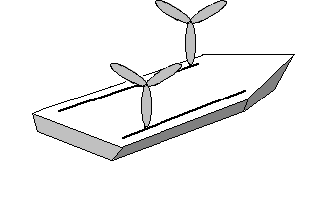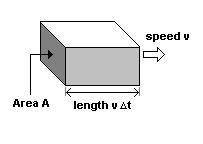| Faster than the Wind ... travelling downwind |
The problem is to travel DWFTTW and ...
>Huh?
That's travelling, in a sailing boat (or maybe a wind-powered bicycle), DownWind Faster Than The Wind.
>On a bicycle?
Yeah. Some guy
(Andrew Bauer) claimed to have done it some fifty years ago.
But let's talk boats.
It occurs to me that:
If the boat is powered solely by the wind, and if the wind energy is "captured" by some device (let's say it's a rotor),
then it's hard to imagine that the rotor can extract energy from the wind if the wind can't catch up to that rotor

>That'd be the case if the rotor were travelling faster than the wind, right?
|
Yeah, so that makes me believe that the rotor must travel slower than the wind ... but (of course) we want the boat to travel faster than the wind ... not (necessarily) the rotor ! Suppose there are TWO rotors:
|  Figure 1 |
>And that's possible? You'll need a lot of gears and stuff and overcome drag and friction and ...?
Well, you gotta pray a lot. 
Okay, let's estimate the energy that can be extracted from a wind impacting some energy-extracting "device"
(such as a sail)
at a speed v ... relative to the device.
>Okay, that's the energy impacting per second, but what's the units?
| 
|
Okay, let's do an example:
We'll use air density as ρ = 1.25 kg/m3>Wow! That should really move the boat, eh? Can one really get that much energy from a 30 knot wind?
The wind speed we'll take as v = 15 m/s ... about 30 knots or 35 mph or 56 km/h
Let's assume A = 100 m2
Then the maximum energy that can be extracted from this wind is
(1/2) (1.25) (100) (153) = 210,938 watts ... about 280 horsepower (see unit conversions )
Well, there's little chance of extracting all the energy associated with the wind, but wind driven generators have been designed to generate over 500 kilowatts from winds in the range 10 to 30 metres per second, but the rotors are HUGE!!
>But even 10% would give us 28 HP, right?
Yeah, but we're talking about a 100 square metre sail so the boat ain't that small and ...
>So how much power is required to move the boat at a speed greater than the wind?
Faster than, say, 30 knots? I have no idea.
However, note that the speed we're using, that's v, is how fast the wind impacts the energy-extracting device.
It's not the speed of the boat.
In fact, if we want the boat to travel at 35 knots in a 30 knot wind, and we want to use a 30 knot v, then the device
must bemoving backward at 35 knots ... relative to the boat.
>Like in Figure 1?
Like in Figure 1.
We might also consider the case where the boat travels at the wind speed
(relative to the wind) heading into the wind.
In fact, as Dave Culp pointed out to me, the notion of having the boat still in the water, heading
into the wind (with the prop used to keep the boat from drifting downwind),
is analogous to a DWFTTW problem.
>Aah, that's a UWETTW problem?
Don't tell me! UpWind Equal To The Wind.
>You're gettin' smarter.
Thanks.
>And that scheme, in Figure 1 ... that's your idea, right?
Well ... uh, I thought so when I first did this tutorial (in Sept, 2004), but then I got e-mail from Peter Sharp who says it's
called rewindmilling. Sharp is currently writing a book (as I write this, in Jan, 2005) called New Sailing Principles.
>Aaah, great minds think alike, eh?
I reckon.
See:
DWFTTW
and On sailing downwind
and Sailcraft that flies
and a neat kite
and Dave Culp on Speed sailing
and Need for an explanation
